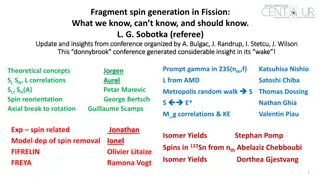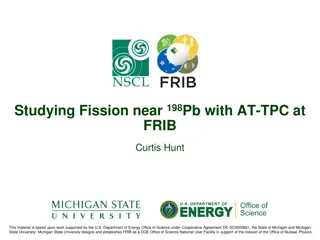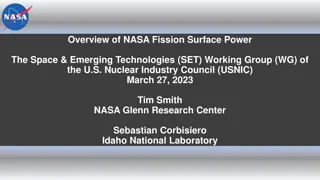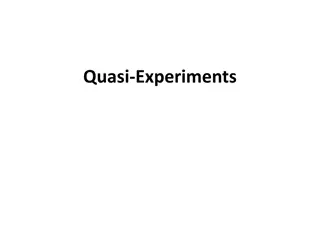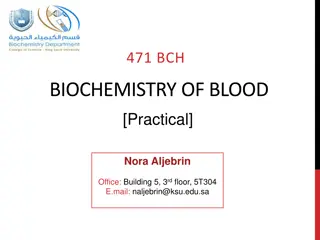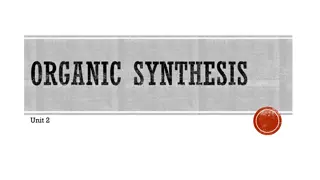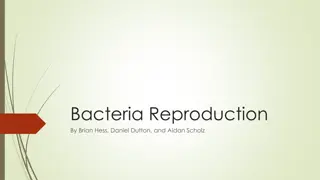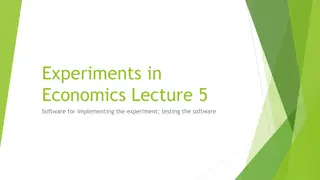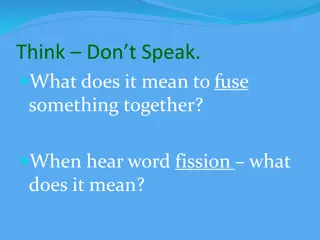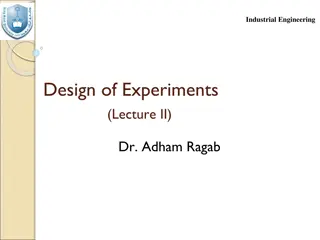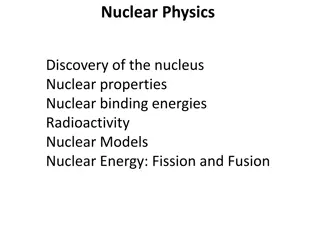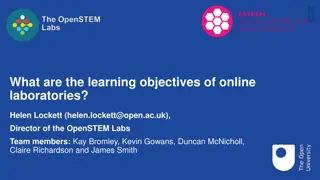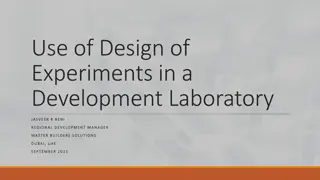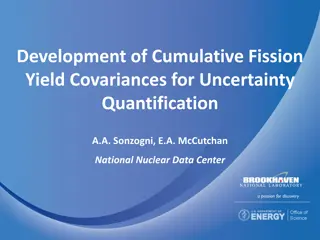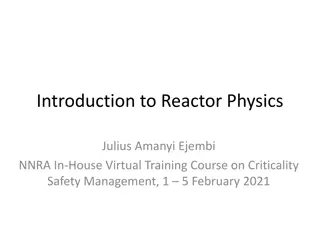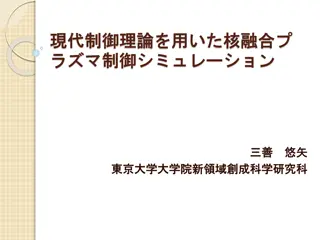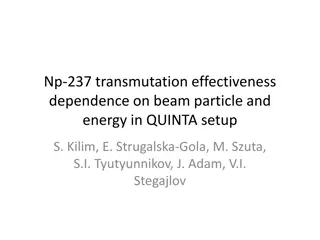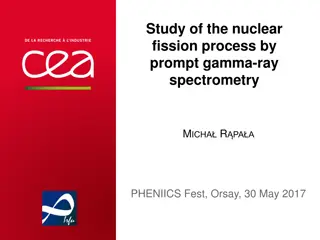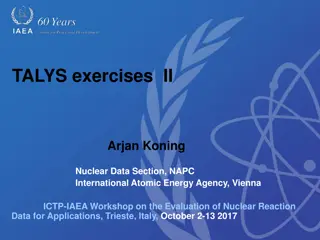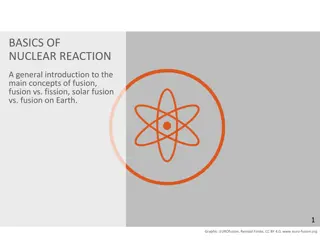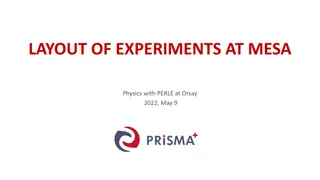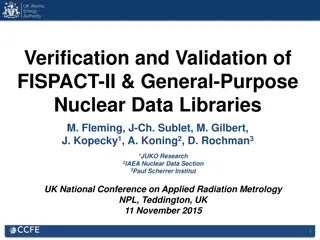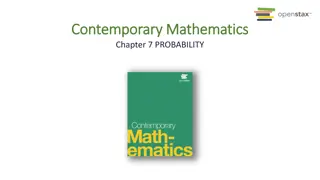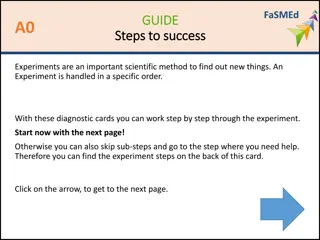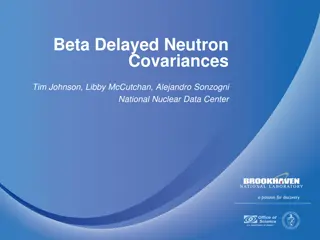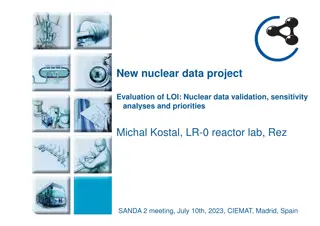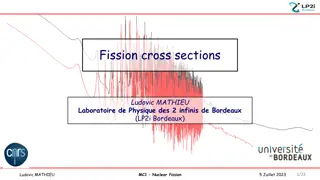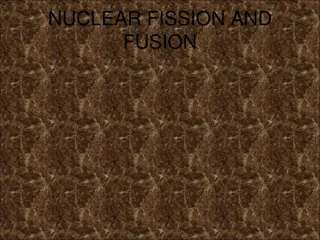Insights on Fragment Spin Generation in Fission: What We Know
Considerable insight was generated from a recent conference on fission, shedding light on crucial theoretical and experimental aspects. Key topics include angular momentum, fission-fragment spin references, and the dynamics of nuclear fission. Theoretical advancements like the TDSLDA model and super
3 views • 41 slides
Exploring Fission Near 198Pb with AT-TPC at FRIB: Insights from Curtis Hunt
Delve into the intriguing world of fission studies near 198Pb using the AT-TPC at FRIB. Supported by the DOE Office of Science, this research probes nuclear structure, fission properties, and fusion-fission reactions. By employing innovative techniques like the Heavy Isotope Tagger and active target
1 views • 39 slides
Italian Positioning and Perspectives in the Euratom-Fission Program
Exploring the Italian participation and achievements in the Euratom-Fission program, focusing on safety, advanced nuclear designs, tritium management, waste disposal, and radiation protection. Key themes include nuclear safety, waste management, radiation applications, and non-call actions. The Hori
1 views • 17 slides
NASA Fission Surface Power Overview: Enabling Sustainable Exploration of Moon and Mars
NASA's Fission Surface Power systems are pivotal for enabling sustainable energy production on the Moon and Mars, essential for human and scientific exploration missions. These nuclear power systems offer robust and continuous power in challenging environmental conditions, making them vital for supp
2 views • 11 slides
Understanding Binomial Experiments and Probability Calculations
Binomial experiments have specific conditions to be met, such as fixed trials and two outcomes. Symbols and notations help represent these experiments. Calculating probabilities of successes in trials involves using functions like binompdf and binomcdf. Examples like determining defective switches o
11 views • 8 slides
Understanding Quasi-Experiments in Research
Quasi-experiments are research studies that resemble experiments but do not involve random assignment of participants to treatment groups. This approach is taken when random assignment is challenging or when ethical considerations come into play. Unlike true experiments, quasi-experiments can provid
0 views • 15 slides
Biochemistry of Blood Practical Course Overview
This biochemistry of blood practical course involves various experiments focusing on blood components such as plasma, serum, proteins, enzymes, blood groups, hemoglobin, glucose levels, and more. The course outline includes detailed experiments, marking distribution, guidelines for writing scientifi
3 views • 6 slides
Understanding Alkane Reactivity: Bond Fission and Halogenation
Alkanes, known for their low reactivity, can undergo halogenation in the presence of sunlight or UV light to form halogenoalkanes. This reaction is significant due to the non-polar nature of alkane bonds and highlights a rare reactivity pathway for these compounds. The process of bond fission, parti
0 views • 135 slides
Insights into Bacteria Reproduction and Cell Division
Explore the fascinating world of bacteria reproduction through binary fission, conjugation, and mitosis. Uncover the similarities and unique aspects of prokaryotic and eukaryotic cell division processes. Learn how conjugation plays a vital role in transferring genetic information between bacteria ce
0 views • 21 slides
Reproduction in Organisms: Overview and Types
Understanding the concept of reproduction in organisms, this content delves into the different modes of reproduction such as asexual and sexual, with examples and illustrations. It covers the life spans of various organisms and details various methods of asexual reproduction like fission, budding, s
0 views • 23 slides
Software Options for Implementing Economic Experiments
Explore various software tools like Z-tree, Visual Studio, and Python that can be used to implement and conduct economic experiments effectively. Learn about the benefits and trade-offs of different software options, and discover online platforms like O-tree and Z-tree unleashed for running experime
0 views • 17 slides
Understanding Nuclear Fusion and Fission in Atoms
Nuclear fusion is the process where two atomic nuclei combine, releasing energy and forming a new element. This process occurs in stars where hydrogen fuses to create heavier elements. On the other hand, nuclear fission involves the splitting of an atomic nucleus, releasing energy. Understanding the
3 views • 35 slides
Introduction to Industrial Engineering Statistics and Experiments
Delve into the realm of Industrial Engineering through Statistics and Design of Experiments in this comprehensive lecture series by Dr. Adham Ragab. Explore the practical applications of statistics, differentiate between population and sample, calculate statistical variables, and understand the sign
0 views • 25 slides
Advanced Fission Experiments at University of Michigan
The University of Michigan, under the guidance of Dr. Sara A. Pozzi, conducts cutting-edge fission experiments leveraging organic scintillation detectors. These detectors offer advantages such as nanosecond-scale response times, energy proportionality, and scalability. The experiments focus on impro
0 views • 4 slides
Unveiling the Fascinating World of Nuclear Physics
Delve into the discovery of the nucleus, nuclear properties, binding energies, radioactivity, and nuclear models. Explore nuclear energy through fission and fusion, uncovering the intricate structure of the atom and Coulomb's law. Witness Rutherford's groundbreaking experiments that revolutionized o
0 views • 14 slides
Understanding the Basics of Experiments in Social Sciences
Delve into the world of experiments in social sciences with a focus on experimental designs, ethical considerations, and intriguing questions like predicting helping behavior in emergencies. Explore how studying helping behavior in experiments can shed light on complex human interactions and behavio
1 views • 30 slides
Understanding the Objectives of Online Laboratories in STEM Education
Online laboratories offer interactive experiments over the internet, providing remote and virtual practical experiences in STEM education. The OpenSTEM Labs project aims to explore various activities and outcomes in experiments, focusing on classification schemes and learning objectives. The purpose
0 views • 17 slides
Utilizing Design of Experiments in Development Laboratories
Design of Experiments (DoE) is a crucial methodology in product development laboratories, enabling faster analysis of multiple factors and interactions. This approach accelerates the product development process and enhances competitiveness in the industry. By incorporating statistical tools and well
0 views • 11 slides
Development of Cumulative Fission Yield Covariances for Uncertainty Quantification
This study by A.A. Sonzogni and E.A. McCutchan focuses on developing cumulative fission yield covariances for uncertainty quantification in nuclear reactors. The research involves calculating cumulative fission yields, using decay data and nuclear databases, to improve accuracy in predicting fission
0 views • 5 slides
Introduction to Reactor Physics and Nuclear Fission
Explore the fundamentals of reactor physics, neutron interaction, and nuclear fission in this virtual training course on criticality safety management. Delve into the history of nuclear fission, symbolisms for atoms, and the significance of critical reactors like Fermi's Chicago Pile. Gain insights
0 views • 73 slides
Advanced Plasma Control Systems in Fusion Experiments
The construction of control systems for high-performance plasma with limited actuators or diagnostics is crucial for ongoing fusion experiments like ITER and DEMO. This involves developing control logic, categorizing various parameters, and understanding actuator systems. Multiple control experiment
2 views • 25 slides
Understanding Hovercrafts: Principles, Experiments, and Applications
Explore the fascinating world of hovercraft technology through detailed explanations, experiments, and insights on how these vehicles work. From the basic concepts and terms to practical experiments you can try at home, uncover the science behind hovercrafts and their versatile capabilities. Dive in
0 views • 17 slides
Implementation of Angular Momentum Formalism in Low-Energy Fusion Reactions
This update focuses on integrating the angular momentum formalism into low-energy fusion reactions using the LISE++ platform. It explores fission barriers, potential energy pockets, compound formation, and de-excitation processes in fusion reactions. The documentation delves into fusion residue tran
0 views • 25 slides
Effectiveness of Np-237 Transmutation in QUINTA Setup
Np-237 transmutation effectiveness in the QUINTA setup depends on beam particle type and energy. The challenging nature of Np-237, with a long half-life and accumulation in nuclear waste, necessitates fission for disposal. Neutron capture results in the production of other actinides, making fission
0 views • 20 slides
Study of Nuclear Fission Process Through Gamma-Ray Spectrometry
Delve into the nuclear fission process through prompt gamma-ray spectrometry, exploring motivations, experimental data, and preliminary results. Understand the gamma heating process in nuclear reactors and its significance in reactor safety. Contextualize the study within Generation III+ and IV reac
0 views • 86 slides
Microbiology Laboratory Experiments Overview
This overview showcases various microbiology laboratory experiments conducted to examine the physiology of bacteria, enzymatic activities, and biochemical reactions. It includes experiments on Phenol Red Dextrose Broth, Phenol Red Lactose Broth, Nitrate Broth, Tryptone Broth, and more. The provided
0 views • 26 slides
Nuclear Reaction Data Workshop Highlights
Explore the TALYS exercises, sample cases, and project insights from the ICTP-IAEA Workshop on Nuclear Data Evaluation. Dive into subactinide fission, neutron interactions with different elements, and resonance parameter reconstruction with TALYS-1.8. Discover the intricacies of fission barriers, Ma
0 views • 13 slides
Understanding Nuclear Reactions: Fission, Fusion, and Energy Release
This content covers various aspects of nuclear reactions, including nuclear fission, fusion reactions, the Manhattan Project, and examples of reactions involving different particles and elements. It explains concepts like exoergic and endoergic reactions, conservation of charge and nucleon number, a
0 views • 34 slides
Understanding Nuclear Reactions: Fusion, Fission, and Energy Production
Explore the fundamental concepts of nuclear reactions, including fusion and fission, the conversion of mass into energy, and the role of fusion in energy production. Discover how the sun and stars shine through fusion reactions and how we can replicate this process on Earth using isotopes of hydroge
0 views • 6 slides
Latest Developments in Physics Experiments at MESA Orsay 2022
Developments at MESA include the layout of experiments, status of the 5 MeV Injector, operational modes, fixed target experiments, challenges in the EB-Experiment P2, procurement updates, energy recovery mode in MAGIX, and upcoming spectrometer deliveries. Exciting advancements and projects are unde
0 views • 16 slides
Verification and Validation of FISPACT-II & General-Purpose Nuclear Data Libraries
The paper discusses the verification and validation of FISPACT-II and general-purpose nuclear data libraries presented at the UK National Conference on Applied Radiation Metrology. It covers new features of FISPACT-II, fusion decay heat experiments, uncertainty quantification, collaboration opportun
0 views • 17 slides
Understanding Multi-Stage Probability Experiments
Explore single-stage and multi-stage probability experiments in contemporary mathematics. Learn how to determine sample spaces of experiments using tree diagrams, tables, and outcomes. Discover the concepts of independence and dependence between stages in multi-stage experiments through practical ex
0 views • 18 slides
Insights into Mass Hierarchy Determination in Long-Baseline Neutrino Experiments
Combining appearance probabilities of electron and anti-electron neutrinos in long-baseline experiments can help determine the mass hierarchy, with ongoing experiments collecting significant data by 2020. Analyses point to CP violation possibilities, with updates expected in Neutrino2016. The capabi
0 views • 6 slides
Steps to Success: Conducting Scientific Experiments
Scientific experiments play a crucial role in discovering new things. Follow a specific order of steps outlined in the guide to successfully conduct experiments. Begin by understanding biological phenomena, formulating hypotheses, planning, performing experiments, observing results, and drawing conc
0 views • 29 slides
Insights into Beta-Delayed Neutron Covariances by Tim Johnson, Libby McCutchan, and Alejandro Sonzogni
Comprehensive analysis and visualization of beta-delayed neutron covariances, fission yields, and their implications in nuclear physics applications. The research covers calculations of delayed nu-bar, neutron probabilities, and recommendations for various systems. Disagreements in fission yields fo
0 views • 26 slides
Cutting-Edge Research in Nuclear Physics
Cutting-edge research in nuclear physics is showcased in this comprehensive list of supported education and training applications. Covering a wide range of topics such as time-of-flight spectroscopy, nuclear reactions, data analysis, and neutron capture measurements, this document highlights the wor
0 views • 6 slides
Nuclear Data Project: Evaluation, Validation, and Sensitivity Analyses
A new nuclear data project focuses on validation in minor actinide and fission product data with the evaluation of 37.6 integral experiments. Priorities include S/U analysis and reduction strategies to meet budget goals. Funding supports new integral experiments for nuclear data validation and large
0 views • 6 slides
Understanding Nuclear Fission Cross Sections
Nuclear fission cross sections play a crucial role in determining reaction rates in nuclear reactors and experiments. They represent the probability of nuclear interactions when neutrons collide with a nucleus, impacting fission and capture rates. These cross sections are influenced by factors such
0 views • 15 slides
Progress Update on Nuclear Data Research at LLNL
Nuclear Data Advisory Group received an online report from Lawrence Livermore National Laboratory detailing progress on various projects, including thermal neutron scattering laws processing, fission data measurements, and PPAC fission chamber development for 240Pu. The report outlines successful te
0 views • 19 slides
Understanding Nuclear Fission: Process, Examples, and Energy Generation
Nuclear fission involves the splitting of an atomic nucleus, with uranium-235 being a commonly used fissile material. When uranium-235 undergoes fission, it produces fission fragments, neutrons, gamma radiation, and kinetic energy. The fission process can be initiated by absorbing a slow-moving neut
0 views • 19 slides
